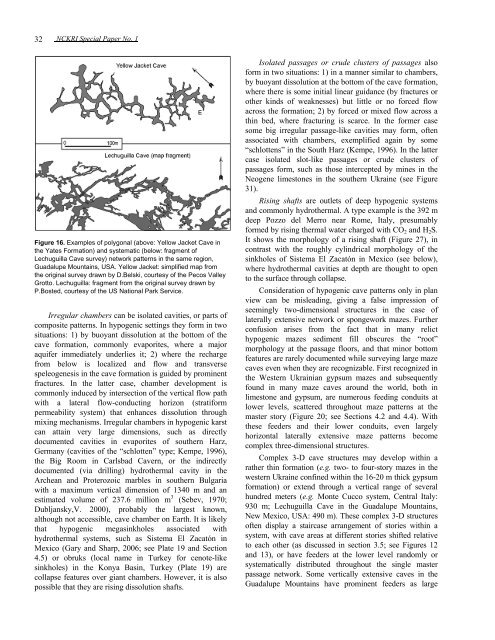Download PDF - Speleogenesis
Download PDF - Speleogenesis
Download PDF - Speleogenesis
Create successful ePaper yourself
Turn your PDF publications into a flip-book with our unique Google optimized e-Paper software.
32<br />
NCKRI Special Paper No. 1<br />
Figure 16. Examples of polygonal (above: Yellow Jacket Cave in<br />
the Yates Formation) and systematic (below: fragment of<br />
Lechuguilla Cave survey) network patterns in the same region,<br />
Guadalupe Mountains, USA. Yellow Jacket: simplified map from<br />
the original survey drawn by D.Belski, courtesy of the Pecos Valley<br />
Grotto. Lechuguilla: fragment from the original survey drawn by<br />
P.Bosted, courtesy of the US National Park Service.<br />
Irregular chambers can be isolated cavities, or parts of<br />
composite patterns. In hypogenic settings they form in two<br />
situations: 1) by buoyant dissolution at the bottom of the<br />
cave formation, commonly evaporites, where a major<br />
aquifer immediately underlies it; 2) where the recharge<br />
from below is localized and flow and transverse<br />
speleogenesis in the cave formation is guided by prominent<br />
fractures. In the latter case, chamber development is<br />
commonly induced by intersection of the vertical flow path<br />
with a lateral flow-conducting horizon (stratiform<br />
permeability system) that enhances dissolution through<br />
mixing mechanisms. Irregular chambers in hypogenic karst<br />
can attain very large dimensions, such as directly<br />
documented cavities in evaporites of southern Harz,<br />
Germany (cavities of the “schlotten” type; Kempe, 1996),<br />
the Big Room in Carlsbad Cavern, or the indirectly<br />
documented (via drilling) hydrothermal cavity in the<br />
Archean and Proterozoic marbles in southern Bulgaria<br />
with a maximum vertical dimension of 1340 m and an<br />
estimated volume of 237.6 million m 3 (Sebev, 1970;<br />
Dubljansky,V. 2000), probably the largest known,<br />
although not accessible, cave chamber on Earth. It is likely<br />
that hypogenic megasinkholes associated with<br />
hydrothermal systems, such as Sistema El Zacatón in<br />
Mexico (Gary and Sharp, 2006; see Plate 19 and Section<br />
4.5) or obruks (local name in Turkey for cenote-like<br />
sinkholes) in the Konya Basin, Turkey (Plate 19) are<br />
collapse features over giant chambers. However, it is also<br />
possible that they are rising dissolution shafts.<br />
Isolated passages or crude clusters of passages also<br />
form in two situations: 1) in a manner similar to chambers,<br />
by buoyant dissolution at the bottom of the cave formation,<br />
where there is some initial linear guidance (by fractures or<br />
other kinds of weaknesses) but little or no forced flow<br />
across the formation; 2) by forced or mixed flow across a<br />
thin bed, where fracturing is scarce. In the former case<br />
some big irregular passage-like cavities may form, often<br />
associated with chambers, exemplified again by some<br />
“schlottens” in the South Harz (Kempe, 1996). In the latter<br />
case isolated slot-like passages or crude clusters of<br />
passages form, such as those intercepted by mines in the<br />
Neogene limestones in the southern Ukraine (see Figure<br />
31).<br />
Rising shafts are outlets of deep hypogenic systems<br />
and commonly hydrothermal. A type example is the 392 m<br />
deep Pozzo del Merro near Rome, Italy, presumably<br />
formed by rising thermal water charged with CO2 and H2S.<br />
It shows the morphology of a rising shaft (Figure 27), in<br />
contrast with the roughly cylindrical morphology of the<br />
sinkholes of Sistema El Zacatón in Mexico (see below),<br />
where hydrothermal cavities at depth are thought to open<br />
to the surface through collapse.<br />
Consideration of hypogenic cave patterns only in plan<br />
view can be misleading, giving a false impression of<br />
seemingly two-dimensional structures in the case of<br />
laterally extensive network or spongework mazes. Further<br />
confusion arises from the fact that in many relict<br />
hypogenic mazes sediment fill obscures the “root”<br />
morphology at the passage floors, and that minor bottom<br />
features are rarely documented while surveying large maze<br />
caves even when they are recognizable. First recognized in<br />
the Western Ukrainian gypsum mazes and subsequently<br />
found in many maze caves around the world, both in<br />
limestone and gypsum, are numerous feeding conduits at<br />
lower levels, scattered throughout maze patterns at the<br />
master story (Figure 20; see Sections 4.2 and 4.4). With<br />
these feeders and their lower conduits, even largely<br />
horizontal laterally extensive maze patterns become<br />
complex three-dimensional structures.<br />
Complex 3-D cave structures may develop within a<br />
rather thin formation (e.g. two- to four-story mazes in the<br />
western Ukraine confined within the 16-20 m thick gypsum<br />
formation) or extend through a vertical range of several<br />
hundred meters (e.g. Monte Cucco system, Central Italy:<br />
930 m; Lechuguilla Cave in the Guadalupe Mountains,<br />
New Mexico, USA: 490 m). These complex 3-D structures<br />
often display a staircase arrangement of stories within a<br />
system, with cave areas at different stories shifted relative<br />
to each other (as discussed in section 3.5; see Figures 12<br />
and 13), or have feeders at the lower level randomly or<br />
systematically distributed throughout the single master<br />
passage network. Some vertically extensive caves in the<br />
Guadalupe Mountains have prominent feeders as large
















